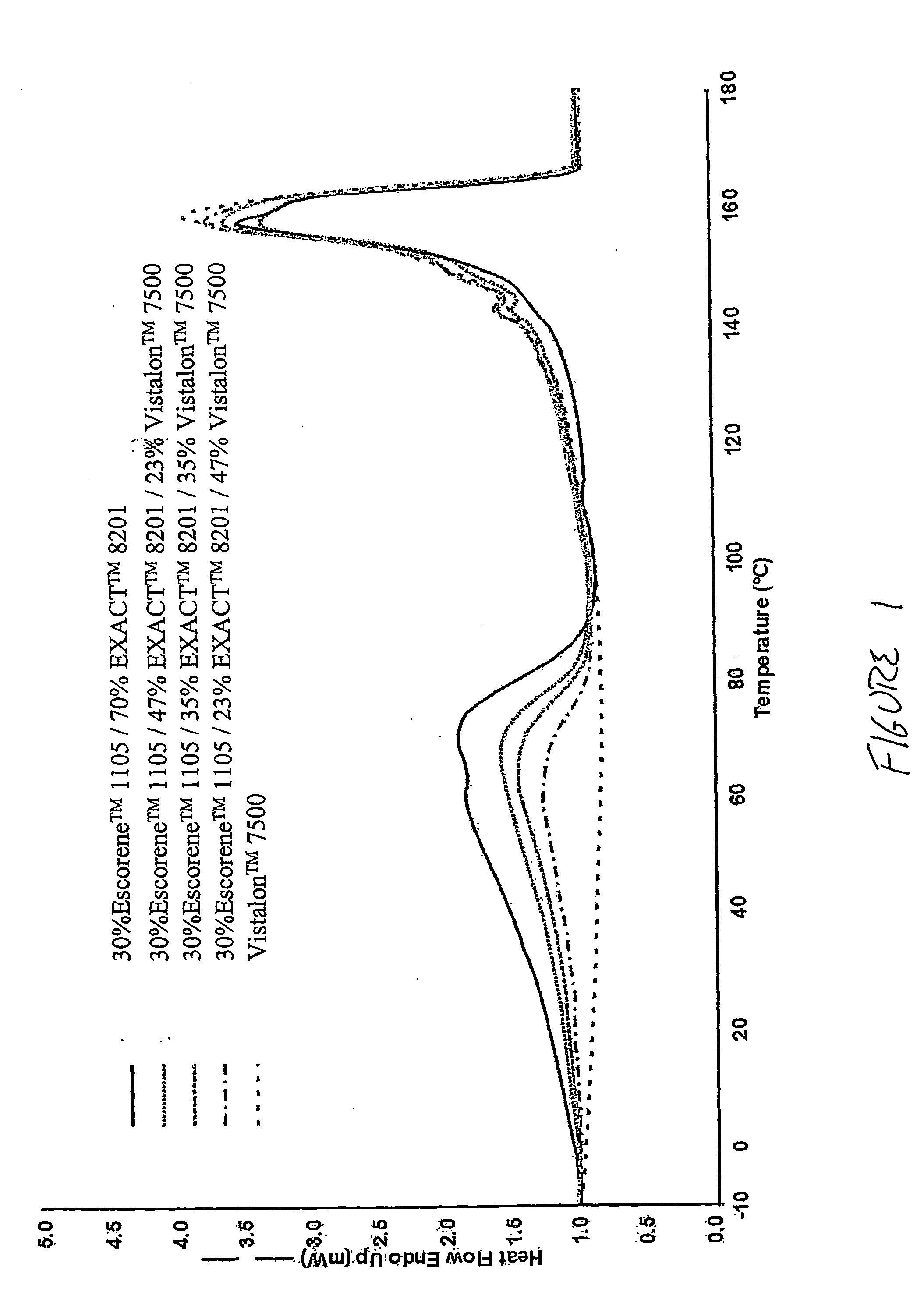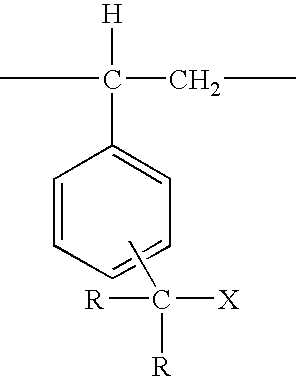Thermoplastic vulcaninates for run-flat tires
- Summary
- Abstract
- Description
- Claims
- Application Information
AI Technical Summary
Benefits of technology
Problems solved by technology
Method used
Image
Examples
example 1
In Samples 1 through 5, various amounts of silane masterbatch (from 1.5 parts per hundred to 3.5 parts per hundred resin) were added to 30 / 0 blends of Escorene™ PP 1105 / Exact™ 8201 and the mixture melt mixed in a 0° C. size Banbury mixer to perform a silane grafting reaction. A batch weight of 2270 grams was used. After the silane grafting reaction was completed, as indicated by a motor torque increase, the feed ram was raised, and 0.2 parts of Epsom salt per hundred parts of resin was added. The ram was then lowered until another torque increase was observed. In order to prevent the material from being heated up to above 500 F, the mixer was shifted to a lower rotor speed to complete the crosslinking reaction. As shown in Table 2, an increased amount of silane masterbatch results in increased gel content, reduced compression set, reduced elongation at break, and a slight decrease in tensile stress and flexural modulus.
TABLE 2SampleSampleSampleSampleSample12345CompositionEscorene...
example 2
Samples 6-11 of Table 3 illustrate thermoplastic vulcanizates having a propylene homopolymer matrix phase and an ethylene based copolymer rubber phase produced by a continuous mixer, as described in detail below. The same resin mixture of Escorene™ PP 1105 / Exact™ 8201 as described in Example 1, together with the silane masterbatch is first melt compounded using a 30 mm ZSK twin screw extruder to complete the silane grafting reaction. In a second pass, the melt blended compound together with Epsom salt was compounded on the same ZSK extruder to complete the crosslinking reaction. The same trends of silane addition on properties are observed as in Table 2.
TABLE 3SampleSampleSampleSampleSampleSample67891011CompositionEscorene ™ PP3030303030301105Exact ™ 8201707070707070Silane22.533.544.5MasterbatchEpsom Salt0.20.20.20.20.20.2PropertyHardness,Shore D@ 0 sec474646454746Elapsed Time@ 15 sec424142404240Elapsed TimeTensile Stress,psi100% Modulus126711801221119012241248200% Modulus1387132...
example 3
Samples 12-17 of Table 4 illustrate TPV compositions having a propylene homopolymer matrix phase, and a rubber phase comprising a combination of a metallocene plastomer and a low crystallinity EPDM rubber. Each of these compositions shows only a polypropylene melting peak by DSC, and no secondary low temperature peak was observed. Also in Sample 14 the Burgess clay served as both a moisture generation agent and a reinforcing agent as indicated by the higher tensile strength of the non-clay containing compounds.
TABLE 4CompositionSample 12Sample 13Sample 14Sample 15Sample 16Sample 17Escorene ™ PP3030303030301105Exact ™ 8201232323Vistalon ™ 36664770Vistalon ™ 75004770Vistalon ™47709303HSilane3.43.43.43.43.43.4MasterbatchSunpar 150 HT10101010Epsom Salt0.20.20.20.20.20.2Burgess Clay 2103.5PropertyHardness, Shore797878717874A @15 sec.Ultimate Tensile,8575791065486831602psiElongation at316321745206622410Break
PUM
| Property | Measurement | Unit |
|---|---|---|
| Temperature | aaaaa | aaaaa |
| Fraction | aaaaa | aaaaa |
| Percent by mass | aaaaa | aaaaa |
Abstract
Description
Claims
Application Information
 Login to View More
Login to View More - R&D
- Intellectual Property
- Life Sciences
- Materials
- Tech Scout
- Unparalleled Data Quality
- Higher Quality Content
- 60% Fewer Hallucinations
Browse by: Latest US Patents, China's latest patents, Technical Efficacy Thesaurus, Application Domain, Technology Topic, Popular Technical Reports.
© 2025 PatSnap. All rights reserved.Legal|Privacy policy|Modern Slavery Act Transparency Statement|Sitemap|About US| Contact US: help@patsnap.com


